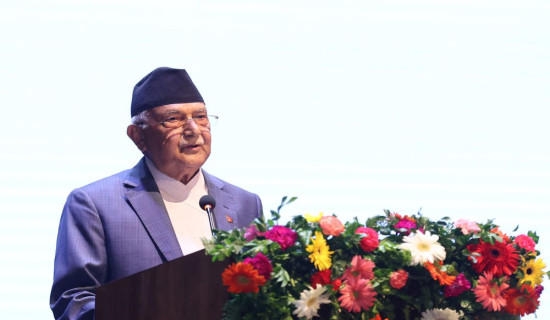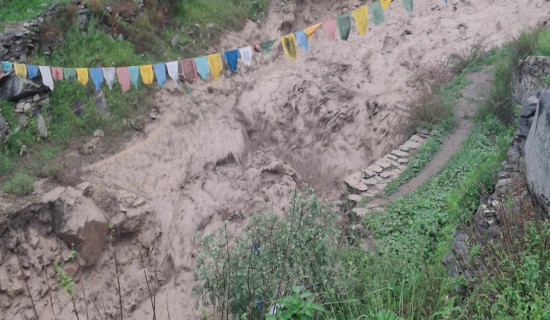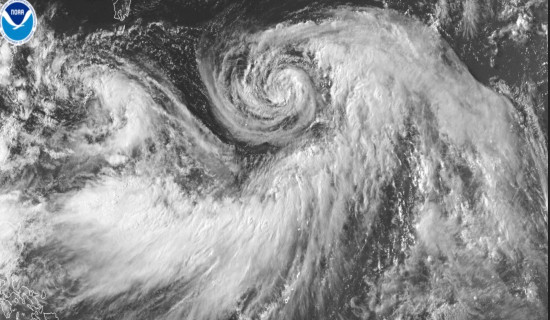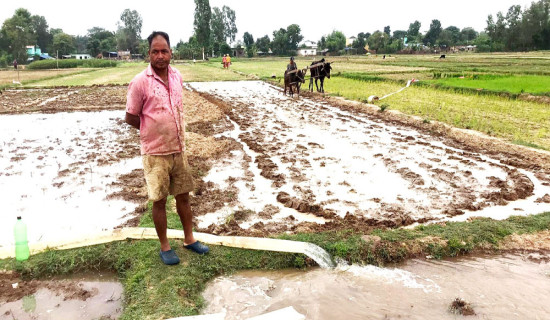- Wednesday, 30 July 2025
Amid monsoon rains, skin diseases surge in Valley
By Pallav Bhusal,Kathmandu, July 5: With the arrival of monsoon, hospitals and clinics, especially the dermatology departments in the Kathmandu Valley, are witnessing a surge of patients with skin diseases.
According to Prof. Dr. Anil Kumar Jha, senior consultant dermatologist and founding executive chairman, DI Skin Hospital and Referral Centre, there is a concern over the seasonal rise in skin infections. He attributed it to the persistent humidity and dampness brought by the rains. “These conditions are particularly common among children and those living in cramped or poorly ventilated areas,” he said.
“In monsoon every year, we witness a rise in cases of fungal infections, eczema flare-ups, bacterial skin diseases, and parasitic infestations,” he said.
The lingering moisture in clothes, frequent wet footwear, and limited exposure to sunlight create the perfect ground for microbes to thrive on human skin, he added.
Dr. Jha, who has conducted multiple long-term studies on dermatological patterns in Nepal, said findings consistently show a seasonal spike in skin conditions. One hospital-based study he led found that fungal infections, acne, and pigmentation issues rise sharply during the rainy months.
In a separate study by Nepal Medical College's Paediatric Dermatology Unit led by Dr. Jha, examined over 2,000 children, finding a marked increase in cases such as scabies, impetigo, seborrhoeic eczema, and heat rashes during the monsoon period.
According to him, many skin-related patients visiting outpatient departments during monsoon months are diagnosed with ectoparasitic infestations like scabies and head lice.
“Humidity softens the skin’s natural barrier, making it more susceptible to microbial invasion,” said Dr. Jha.
Fungal infections like ringworm and athlete’s foot are often the result of staying in wet shoes or wearing unwashed damp clothes. He added that yeast-related infections, such as pityriasis versicolour, tend to develop on oily or sweaty skin, while eczema and seborrhoeic dermatitis often get worsened in the moist environment.
Bacterial infections like impetigo, which are more common among children, can easily spread when small cuts or insect bites go untreated. Scabies and lice, both parasitic in nature, thrive in conditions where hygiene is compromised.
Dr. Jha urged the public to remain vigilant about skin hygiene during the rainy season. He advised changing damp clothes as soon as possible, ensuring the body is dried thoroughly, especially in skin folds, and choosing breathable, cotton-based clothing instead of synthetics that trap moisture.
He also stressed the importance of not ignoring early signs of infection. “A minor fungal patch, if left untreated, can turn into a more serious bacterial problem,” he said. In Kathmandu, reports about head lice outbreaks and increased skin rashes among schoolchildren have already been there. Some schools have noted a rise in complaints of scalp irritation among their students, while local pharmacists confirm they have seen an increase in the sale of antifungal creams, medicated shampoos, and scabicidal ointments over the past few weeks.
According to Dr. Jha, skin conditions remain one of the most common reasons for outpatient visits across Nepal, regardless of the season. But the monsoon always brings a predictable spike.
Data from mobile health camps in the rural districts show that eczema alone accounts for over 30 per cent of skin-related complaints, followed by infectious and pigment disorders.
Dr. Jha is also the Founder Chairman of community health education and services by telehealth (C.H.E.S.T.) Nepal, a non-profit telehealth initiative started in 2009. C.H.E.S.T. provides dermatological care and vocational training to rural communities through telemedicine using both real-time and store-and-forward methods. Over 500 patients have benefited so far.
He stressed that while monsoon-related skin issues are common, they are largely preventable through early action and better awareness. “The rains are a blessing to get rid of heat, but they bring hidden health risks as well. If people are informed and take basic precautions, we can keep many of these problems at bay,” said Dr. Jha.
With more rain forecast in the coming weeks, dermatologists across the valley are bracing for an influx of cases. Though the risks may be seasonal, Dr. Jha believes the solutions are within reach, rooted in awareness, hygiene, and timely medical care.




-square-thumb.jpg)
-square-thumb.jpg)










